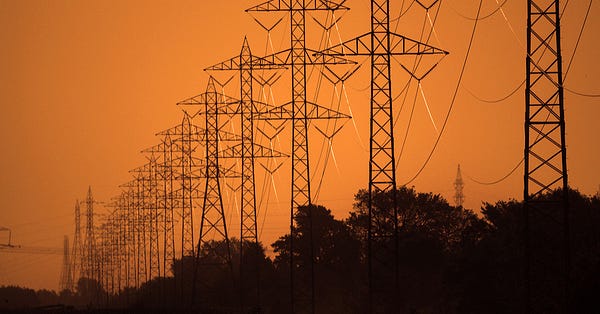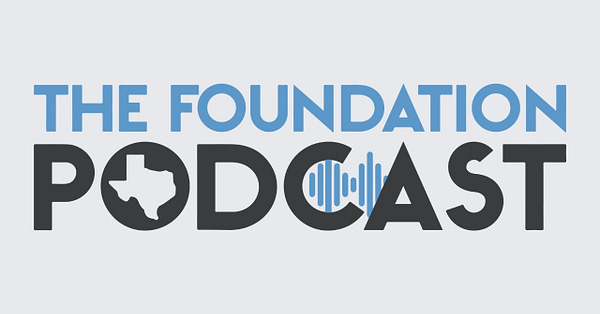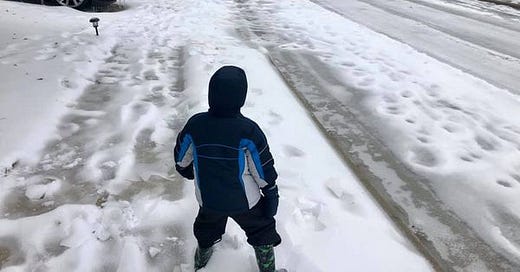18. Texans Power On: The Real Story
In this newsletter, I discuss the real story behind the power situation in Texas, the reason to not expand Medicaid, a pro-growth agenda, and the substantially improving COVID-19 situation in TX.
Hello Friend!
My apologies for the delay in this newsletter. I usually write it on Sunday evenings and then have it automatically posted and emailed on Monday mornings at 5:30 am, which seems to be a good time given an open rate of around 25% compared with lower rates on other days and times. If you have suggestions, please let me know. But given the severe winter weather system that hit Texas, including in Round Rock where I live 25 miles north of downtown Austin, starting on Thursday afternoon and continued for most of the next week, I didn’t get a chance to write a post.
Before I go through the last week, I would like to follow up on my last newsletter and say that I’m glad to see Tom Brady win another ring, though I thought Patrick Mahomes (Texas Tech!) did pretty well given the ferocious Bucs’ defense and poor Chiefs’ receiving crew. If Brady doesn’t retire in the next couple of years, we might see these two in the Super Bowl again. Fortunately, pitchers and catchers reported to Spring training, so baseball is around the corner.
Also, I hope you had a fantastic Valentine’s Day. Here’s what I shared with my wife. :)
Back to the rough weather and power situation during the last week. As the winter storm blew in, we experienced very cold temperatures in the single digits with a negative degree wind chill for multiple days, which is unheard of in Texas where I’ve lived my entire life except my year in Virginia while working at the White House. It was brutal for this Texan. After the initial ice storm on Thursday, the snowstorm started on Sunday and that seemed to have really been a major turning point on the electrical grid when many more people lost power.
We lost power on Monday morning at 9 am. My wife and two young boys made the best of it by playing games and running around to get their energy out. The temp in the house continued to drop.
After it was nearing 60 degrees and dropping, we decided it was time to move somewhere else as there was no end expected to the power outage and the temperatures were going to remain extremely low in the coming days. We are blessed with great friends and they invited us to stay at their place two miles away. We headed there around 4 pm on Monday. The weather continued to be brutal and the road conditions worsened the next couple of days. We received a text message that our power turned back on in the afternoon of Wednesday but the road conditions were too bad to return home.
Fortunately, we were able to head home on Thursday morning with power and water at our house. The first day that the temperature was above freezing in about a week was on Friday, so much of the snow and ice has turned the roads and yards into a giant slushy. But we’re blessed to be home, warm, and full of appreciation for our friends and family.
Here is a picture of my youngest son looking down the road at my wife and friends. He got tired of battling almost slipping multiple times so I picked him up and carried him back to our friends’ house soon after taking this picture. That was a “fun” slide back to the house. Ha!
Now let me share some of my thoughts on the electricity situation because there’s been a lot of noise going around.
It’s been very frustrating to see the manipulation by the progressive media make their case for unreliable energy sources (wind and solar) at a time when they clearly failed. There were issues with thermal energy (natural gas, coal, and nuclear) production freezing and the attempted rotating blackouts not working and tripping the production offline, but if it hadn't been for thermal energy then we would have had many more and much longer blackouts.
I tweeted about this quite a bit and I suggest that you go to my Twitter page to view this as it was happening in real-time. I tried to provide screenshots of the market situation provided by ERCOT over time. I would also highly recommend going over to TPPF’s new commentary website The Cannon Online to read the articles published by my colleagues to understand the real story.
There are many trolls who are going to spin this as they see fit. There is much blame to go around for this colossal failure with what I count as three primary causes:
1) Freezing from a historic winter weather event,
2) ERCOT grid mismanagement, and
3) Poor policies over time prioritizing unreliable sources of energy.
There are some who are arguing that it was a market failure because of the deregulation of the electricity market a while back, but that’s an easy scapegoat when really it’s a combination of an unprecedented natural disaster, fault of a flawed board of directors, and government failure. I don’t see it as a market failure and if the system had been regulated (see California) or connected to the interconnected grid then the situation would have likely been much worse.
In fact, two things that Texas shouldn’t do because it would give the federal government more control of what’s happening here and therefore cause more problems are:
1) Expand Medicaid
2) End Independent Grid
Here’s a WSJ article that highlights a lot of what happened over the last week, though I think that they overlook the key causes of the problem and instead focus on how private companies and the deregulated market failed…typical of the media.
Check out the following EIA chart that goes back for the last 30 days and other data and insights over the last week. They show the huge ramp-up in electricity generated from natural gas and an increase from coal but how the others, especially wind, dropped substantially, but sure it’s just a natural gas problem.








Just think if natural gas had been at the level before the ramp-up in electricity generation, there would certainly have been many more blackouts and for much longer.
Let’s stop the politics and actually look at the facts. I’m sure some will say that I’m falling prey to politics, but the data prove that’s not the case. My view is that we need an all-of-the-above approach when it comes to energy production, but that we shouldn’t use taxpayer dollars to prioritize any source of energy whether they be reliable or unreliable, though more electricity generated by reliable sources of energy will be the outcome without unreliable sources being propped up at our expense.
If you want to learn more about what happened in Texas and what should be done about it, don’t miss this complimentary TPPF Livestream event on Monday 2/22 at noon that was tweeted by my colleague:


It remains not a good situation in Texas as hospitals are running out of water and are having to use the restroom in bags, about 105,000 customers are still without power across the state which could represent 3 to 4 times that many Texans depending on how many are in each household, and there are boil water notices in many places.
This last week has felt a lot like the COVID-19 lockdown, but worse because at least with the lockdown we had power, water, and it wasn’t freezing with snow on the ground outside. Unfortunately, there have been at least 24 known cases of cold weather-related deaths, with likely many more to come. And this event likely influenced the COVID cases by people staying together inside more often and may influence hospitalizations and deaths as people didn’t go or couldn’t go to the hospital.
If you’re influenced by this natural/man-made disaster and are struggling, please reach out to me. Name it, I will try to help! Coming together with people helping people to solve problems is the Texas way. As a devout Christian, I’m continuing to pray for God’s grace, peace, security, and comfort to be around me, my family, my friends and loved ones, and everyone dealing with this situation.
With that said, let’s jump into the other issues that have been going on since my last newsletter. They don’t seem nearly as important given recent events, but I think there continue to be many pressing issues in Texas, in DC, and with the COVID situation. So, let’s power on to find ways to let people prosper in their unique way by expanding liberty in an institutional framework whereby there are limited constitutional roles for governments.
TEXAS ECONOMIC AND FISCAL SITUATION
Here’s TPPF’s The Foundation Podcast that includes my explanation of what’s up with the COVID-19 situation in Texas, what is the BRE, what the base versions of the Texas budget look like so far, and how those versions compare with TPPF’s Conservative Texas Budget. Listen:





Here’s TPPF’ Responsible Recovery Agenda that should be used in other states and in DC to regain people’s prosperity fast: less spending, less taxing, less regulating.


There is a push by some in Texas to expand Medicaid. They argue that more people currently without insurance should get coverage and that Texas would get its money back from the federal government.
These are both myths as those currently on Medicaid don’t receive quality care and most doctors aren’t accepted new Medicaid patients, which is a reason that coverage doesn’t equal quality care. If you think that the federal government is just holding onto our money, then I’ll point you to the $3.1 trillion deficit last year and the multi-trillion-dollar deficit expected this year…that money isn’t just waiting for us to use and if trends in other states are a guide then Texas will be spending much more than the close to $6 billion it’s expected to cost.
Finally, there is no “multiplier effect” from expanding Medicaid, as argued in the commentary below, because it is just a redistribution of taxpayer dollars. The estimates for a multiplier effect are bogus from poor assumptions based on what they want the outcome to be rather than understanding how the economic system works.
In short, Texas must never expand Medicaid, instead, Texas should lead the way with a market-based healthcare system.


What should Texas do with the almost $17 billion to the state from the $1.9 trillion COVID “relief” package being discussed in Congress? It would be great if Texas rejected it because we don’t need it as there’s no shortfall. Below is more on this and how many blue states are getting much more than red states even though they’ve been spending too much for years. Really, the entire $1.9 trillion package (good overview by CRFB) shouldn’t be passed given that too much taxpayer money has already been spent and the key thing to get the economy going is to open it up by state governors instead of continuing to bankrupt the country and distort people’s behavior.


Check out this good comparison of Texas versus California. While Texas typically wins when it comes to economic freedom and prosperity, just look at the many California’s businesses and people moving to Texas, the Texas Model should be improved by the Texas Legislature this session.


U.S. ECONOMIC AND FISCAL SITUATION
Here’s my latest op-ed on the failures of a government-mandated-to-unemployment minimum wage that some falsely claim there is a conservative case to raise. I crush that nonsense in this commentary.


I’ll keep making this point and pushing for a Responsible American Budget so that we aren’t riddled with less prosperity from the redistribution of taxpayer dollars through government and from a debt crisis.


OPEN TEXAS (AND AMERICA)
Summary of COVID-19 Situation in Texas: TX DSHS Data Here
As of Feb. 19, only 5 of 22 Trauma Service Areas (TSA) are on the Governor’s list for elevated restrictions as a business operating capacity is cut from 75% to 50%, which is a substantial improvement over the last two weeks with now 14% of Texans living in these more restricted TSAs.
COVID-19 cases, fatalities, and case-fatality rate are all improving and hospital beds available remain around normal for the last year.
Based on these data and others below, there remain valid concerns about the Governor’s metric of COVID-19 patients/total hospital beds to shut down businesses instead of available beds/total hospital beds as beds have increased over time by targeting resources where needed most, and about the continued mistake of blanket restrictions across Texas, which hurt lives & livelihoods.
Overview of COVID-19 in Texas
7-day avg of new confirmed cases in Texas is substantially down recently to around 4K on Feb. 18, the recent high of 26,543 on Jan. 5
7-day avg of new reported fatalities in Texas on Feb. 10 (latest data available) was about 140—more recorded death certificates to come which have increased the 7-day avg to around 200 per day over last month
7-day avgs on Feb. 10 of new cases were the same as the highs in July (10K vs. 10K) while reported new fatalities were 44% lower than July highs (140 vs. 250), meaning the case-fatality rate is substantially lower
There remains a relatively high rate of hospital beds available across most of Texas—22.7% available statewide—with every TSA having at least 13.5% available
7-day avg of testing is about 110K per day and the positivity rate is down to 11.3% after recently peaking at 21% on Jan. 3 which was near July high
Improvements in the case-fatality rate could be from better therapeutics, younger and healthier population infected, better utilization of hospital resources, and Gov. Abbott’s more targeted policy approach
Texas Gov. Abbott’s Metric Overview
Per Gov Abbott’s metric of COVID-19 hospitalizations as a share of total hospital capacity for seven consecutive days, TSAs below 15% can have most business restrictions lifted to 75% operating capacity (up from 50%), keep state mask mandate (been in effect since July 2), and bars (and others) open to 50% capacity with county judge’s approval
5 of 22 TSAs are reported on the list of further restrictions: I (El Paso), R (Galveston), S (Victoria), T (Laredo), and V (Rio Grande Valley)
14% of Texans are at 50% capacity + other restrictions while 86% of Texans are at 75% capacity + other restrictions, so this has substantially improved
This CV19-to-capacity metric statewide has been declining statewide to 11.8%, which is below July’s 17.0% average
Hospital Overview Statewide
COVID-19 hospitalizations down 10% (to 7,757 hospitalizations—lowest since 11/15) from 7 days ago & down 24% from 14 days ago, level below July’s 9,700 avg
Hospital beds available statewide is down to 22.7%, below the avg of 23.7% in July and below the avg of 26% since May
Hospital capacity down 4.6% (to 65,826 beds) from 7 days ago and down 5.2% from 14 days ago, level is well above July’s 57,000 avg








Closing Thoughts
It’s been an interesting, trying week or so. While that’s the case, I continue to feel blessed to have a wonderful family, have a passion for helping others, have terrific colleagues and friends, and have what brings this all to fruition from my faith in an almighty God who brings me through every challenge.
And finally, here’s a quote from the one-and-only economist Friedrich Hayek:
Thanks again for reading! If you haven’t signed up for my newsletter yet, please subscribe here at no charge and share with others. Many blessings to you and yours. Have a wonderful week and try to find things your for a little bit more this week.
Vance Ginn, Ph.D. | www.vanceginn.com | #LetPeopleProsper











